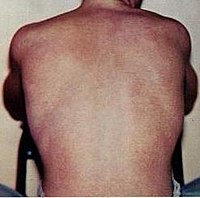
Photo from wikipedia
SARS‐CoV‐2 and dengue virus co‐infection cases have been on the rise in dengue‐endemic regions as coronavirus disease 2019 (COVID‐19) spreads over the world, posing a threat of a co‐epidemic. The… Click to show full abstract
SARS‐CoV‐2 and dengue virus co‐infection cases have been on the rise in dengue‐endemic regions as coronavirus disease 2019 (COVID‐19) spreads over the world, posing a threat of a co‐epidemic. The risk of comorbidity in co‐infection cases is greater than that of a single viral infection, which is a cause of concern. Although the pathophysiologies of the two infections are different, the viruses have comparable effects within the body, resulting in identical clinical symptoms in the case of co‐infection, which adds to the complexity. Overlapping symptoms and laboratory features make proper differentiation of the infections important. However, specific biomarkers provide precise results that can be utilised to diagnose and treat a co‐infection, whether it is simply COVID‐19, dengue, or a co‐infection. Though their treatment is distinguished, it becomes more complicated in circumstances of co‐infection. As a result, regardless of whatever infection the first symptom points to, confirmation diagnosis of both COVID‐19 and dengue should be mandatory, particularly in dengue‐endemic regions, to prevent health deterioration in individuals treated for a single infection. There is still a scarcity of concise literature on the epidemiology, pathophysiology, diagnosis, therapy, and management of SARS‐CoV‐2 and dengue virus co‐infection. The epidemiology of SARS‐CoV‐2 and dengue virus co‐infection, the mechanism of pathogenesis, and the potential impact on patients are summarised in this review. The possible diagnosis with biomarkers, treatment, and management of the SARS‐CoV‐2 and dengue viruses are also discussed. This review will shed light on the appropriate diagnosis, treatment, and management of the patients suffering from SARS‐CoV‐2 and dengue virus co‐infection.
Journal Title: Reviews in Medical Virology
Year Published: 2022
Link to full text (if available)
Share on Social Media: Sign Up to like & get
recommendations!